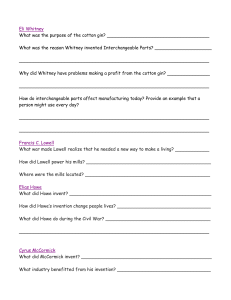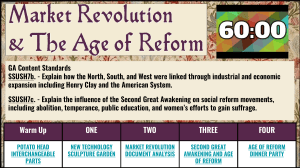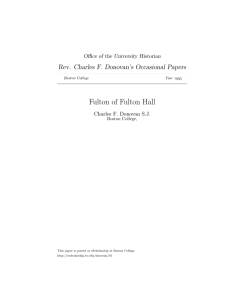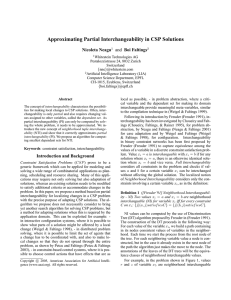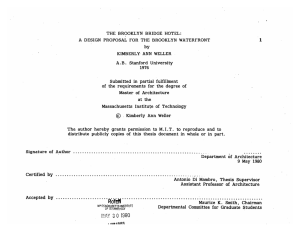The Industrial Revolution and Society
advertisement
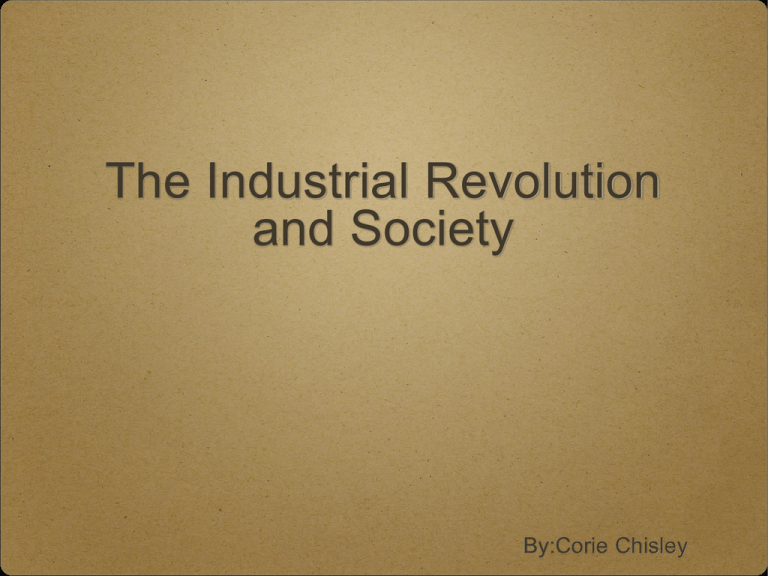
The Industrial Revolution and Society By:Corie Chisley Industrial Revolution What was it?- the transition to new manufacturing processes in the 1830's. Things went from being made by hand to machinery. Impact on society?- Most people had to begin working in factory's, which was new to everyone. Eli Whitney and Interchangeable Parts Who was he?- Eli Whitney was an inventor who invented the cotton gin and many other things. He was head of a mass production of muskets, which were an interchangeable part. Interchangeable parts are parts for practical purposes that can be made in large masses and are indentical. Lives Changed Workers ranged between the ages of about 7-60. In the beginning of the revolution workers lives were flipped. Some went from working peacefully in the country to being forced to word long, hard hours in a factory. Rhode Island and Lowell Systems Rhode Island system- a system of labor created by Samuel Slater that used families, including small children, as laborers to work on spinning his cotton mill. Lowell system- a system that used "mill girls" to work in textile centers to earn more money than they could at home. They usually stayed in company boarding houses away from family. Trade unions, strikes, and collective bargaining trade unions- An organization whose membership consists of workers and union leaders, united to protect and promote their common interests. strikes- a refusal to work organized by a body of employees in usually attempt to gain concession from their employer. Collective bargaining- negotiation of wages and other conditions of employment by an organized body of employees. Early efforts at labor reform Beginning with the workingmen’s parties of the 1830s, the people of equal rights made a series of reform efforts that went through the nineteenth century. Most notable were the National Labor Union, launched in 1866, and the Knights of Labor, which reached its peak in the mid-1880s. Trade unionism tended to the workers’ immediate needs, labor reform to their higher hopes. Fulton, and Gibbons v. Ogden Fulton and the steamboatRobert Fulton designed and built the first successful commercial steamboat, the Clermont. Gibbons v. Ogden- a landmark decision in which the Supreme Court of the United States held that the power to regulate interstate commerce was granted to Congress by the Commerce Clause of the United States Constitution. Transportation revolution The Panic of 1819 alerted many to the need for more effective transportation of goods. Most rivers west of the Appalachians ran north to south, so they could not connect western farmers with the eastern markets where their goods were sold. The National Road was the primary connection between east and west, and it advanced further west each year. In addition, between 1815 and 1825 seven northern states built toll roads, or turnpikes. However, this did not solve the problem of transportation. Horse-drawn wagons had very limited capacity and roads were very expensive to maintain. So interest turned toward the concept of water transportation. Growth of Railroads to 1850 . In 1830, the South Carolina RailRoad Company was formed to draw trade from the interior of the state. It had a steam locomotive called The Best Friend of Charleston the first steam locomotive to be built for sale in the US. A year later, the Mohawk & Hudson railroad reduced a 40-mile wandering canal trip that took all day to accomplish, to a 17-mile trip that took less than an hour. Its first steam engine was named the DeWitt Clinton after the builder of the Erie Canal. Technological advances 1829- typewriter 1832 - stereoscope 1835- propeller 1839- bicycle 1846-sewing machine 1859- dishwasher http://webs.bcp.org http://www.encyclopedia.com http://www.sparknotes.com/history/american/westwardexpansion/se ction5.rhtml http://www.businessdictionary.com/definition/trade-union.htmlg http://study.com/academy/lesson/the-transportation-revolutionturnpikes-to-steamboats-to-railroads.html http://www.history.com/topics/labor http://theinventors.org/library/weekly/aa111100a.htm www.google.com

